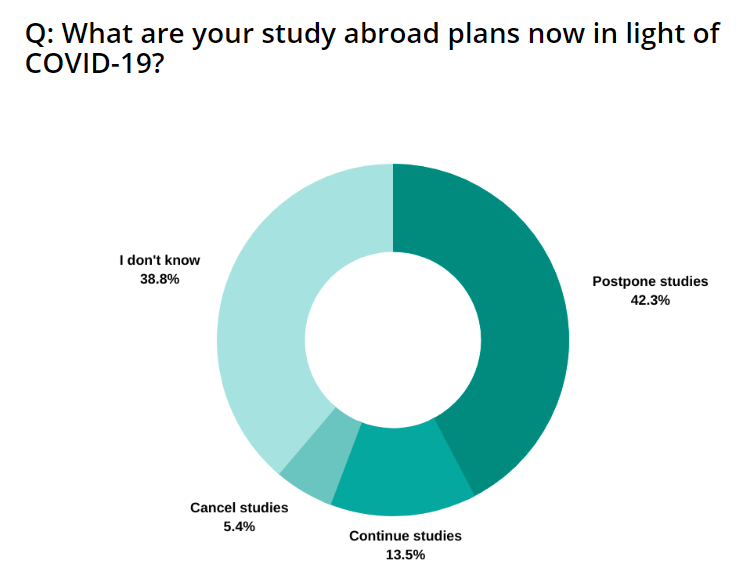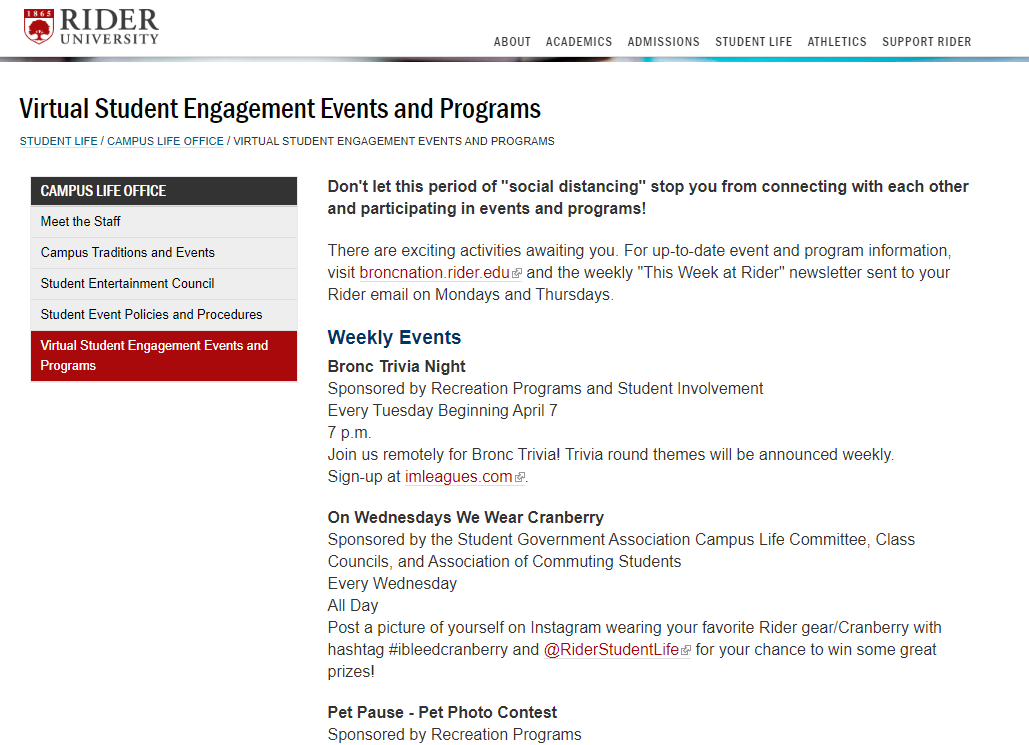
A target persona is meant to be a living document. Comprising a broad picture of your audience’s most common shared characteristics, values, and needs, personas should be reviewed if at any point you feel the overall makeup of them has significantly changed.
The COVID-19 pandemic is a perfect case in point for schools. With new restrictions and uncertainties surrounding travel, course delivery, and demand, institutions in all areas of the education sector need to revaluate what their future students might look like. What will their motivations and pain points be, and what demographics should you be targeting for success?
Redefining your personas will give you a better sense of how to approach your digital marketing and admissions efforts across the board. Here are a few things you should consider to get started.

Are Your School’s Personas Online or Offline?
One of the biggest questions hanging in the air for many schools right now is exactly what form their courses will take come their next intake dates. In the wake of the COVID-19 outbreak, many institutions moved quickly to transition to online delivery in order to ensure that students could continue their studies.
Now, looking ahead, there is a lot of uncertainty among both schools and prospective students about whether these courses will remain online in the coming months, or if they will return to campus.
The answer to this question could drastically alter the makeup of your student personas. Those that simply want to earn their qualifications will likely be interested in proceeding regardless of how their courses are delivered. However, those that are particularly invested in getting an on-campus experience or have misgivings about online learning may choose to delay their studies.
Example: This persona of an international student paints a picture of an adventurous traveler who may not be particularly drawn to online learning.

Conversely, there may be a small number of prospects who are more likely to consider your courses if they are offered online, as well as several who will be reassured that online learning is an option should it not prove safe to return to the classroom.
Answering these questions and reviewing your personas can help to guide your decision-making with regards to your student recruitment initiatives. For instance, if you are offering online courses – whether as an official alternative or as a contingency plan – you may want to evaluate your visibility in searches specifically related to online learning.
If you have not devoted time to building up your reputation in this area, you will be less likely to attract leads. Thus, your pool of prospective students is likely to be smaller unless you significantly invest in promotion.
You should also pay attention to the quality of your current online course delivery. If your courses were transitioned quickly, your audience may be concerned about what to expect. Reassuring them that opting for your school will be worthwhile over those with more established online programs will be key to persuading them.
Where you are looking to generate leads for classroom-based courses, the current state of affairs in your region will likely dictate how much success you can hope to achieve. How soon can you realistically expect to be able to reopen your campus? With restrictions in some regions around the world gradually easing, schools in certain locations may find themselves with a competitive advantage when it comes to promoting classroom-based courses.
Where Will Your Future Students Come From?
International student recruitment has become a huge part of the education economy, with many institutions of different kinds across the sector relying heavily in enrollments from abroad to reach their targets.
For these schools, the ramifications of the pandemic are especially worrying. Even once lockdowns in specific areas are lifted, travel restrictions may stay in place for a considerable amount of time.
Fear of a second wave or a similar outbreak may also discourage students from studying abroad in the long-term, regardless of whether they can travel freely or not. To a lesser extent, this could also hurt domestic enrollments from other parts of your country.
As a result, many schools may have to recruit more students locally. This can be more challenging, as you may find your institution competing for a smaller pool of prospects with other local schools – many of which will likely be looking to offset a drop in international enrollment numbers as well.
Example: A student persona example of a local candidate for an MBA program.

Having said that, it’s important not to overstate the effect of COVID-19 on the international recruitment market. An April survey conducted by educations.com among 7,400 prospective international students suggests that while the sector will definitely see a negative impact, the news isn’t all bad. For one thing, while many students said they had decided to postpone their studies and others were unsure of plans, only 5.4% of respondents had outright decided to cancel:

As much as their will likely be a decrease in inquiries and enrollments in the immediate future, schools with strong international recruitment presences would be unwise to completely discount it just yet.
Furthermore, close to 45.2% of respondents said they would be interested in pursuing their chosen program if it was offered online:

This suggests that it may be possible to mitigate the damage done to your international enrollment numbers if you can offer online learning as an alternative. While international prospects show a marked preference for studying on campus, schools that can convince them that the standard of learning and qualifications they offer are worth the investment could still be able to attract students. Indeed, some with strong reputations for online education may even be able to target a more diverse array of countries and regions than before.
How Attractive is Your School’s Location in a Post-COVID-19 World?
In addition to re-evaluating where your students come from, you may also have to take a second look at where you are. Many schools use their location as a big part of their value proposition, highlighting the lifestyle, attractions, and strategic career benefits afforded to students by studying there. In the aftermath of COVID-19, however, perceptions of your location among your target audience may have changed significantly.
For a start, schools that are currently only offering classes online obviously can’t use their location as a selling point. Those that are shifting their focus towards local students in the medium term will also need to change the way they present their location. After all, prospects who already live nearby don’t need to be told about all the things there are to see and do in the area.
Even when attempting to court students from further afield, you may find that the advantages and disadvantages of your location have changed, for better or for worse. For example, the fact that the COVID-19 outbreak was more widespread in larger cities may make studying in big urban centres less attractive to students. Countries where the scale of the outbreak and response was perceived as worse than others may also become less desirable study destinations.
Conversely, institutions in small towns and rural areas may be more popular among students over the next few years, as they will regard them as a safer place to be should another situation like this occur.
Example: Unity College takes great pride in promoting its location, centred on 225 acres of lakeside woodlands in Maine. This kind of rural setting could become more popular among students in the future.

Regardless of where you are, however, certain things about your location will be unlikely to be central to your prospect’s motivations in the short-term. Nightlife, attractions, outdoor activities, and opportunities for travel to surrounding areas will all be off the table until such a time as people are certain that lockdowns can be safely lifted. The challenge for schools that have used these benefits to attract students in the past will be to find other advantages to replace them.
What Can’t You Offer Anymore?
Just as prospects will be unable to enjoy everything your surrounding area has to offer right now, your school may also be unable to provide a lot of the extracurricular activities your students may have previously enjoyed.
If your institution previously organized trips, offered clubs and societies, or had its own sports and recreation options, these may all be off the table for a while, and you will need to find other ways to engage prospects who would have been attracted to this aspect of student life.
Offering virtual alternatives to some of these activities may be an option where it is possible. Socializing and trying new things is an important part of the educational experience for many, and finding a way to replicate it in a post-COVID-19 world could be a big advantage for your school.
Example: Rider University has been hosting a series of virtual events throughout COVID-19, which include trivia nights, photo contests, and other fun activities.

In addition, for as long as schools remain closed, other resources that might have appealed to prospects will be limited, too, such as student accommodation, libraries and other campus amenities, and any training equipment and facilities.
All of these things can play a role in the decision-making process of your personas and often make the difference in them choosing your school over others. In their absence, finding other advantages will be essential.
When Do Students Plan to Study?
Believe it or not, many schools in certain areas of the education sector may actually be seeing a spike in the number of new leads coming in as people consider their options for the future.
The catch is that very few of these students are progressing towards applying, with the uncertainty of the current situation essentially leaving them stuck in the ‘Awareness’ stage of the process.
With that in mind, it may be worth reviewing the typical enrollment journey of your personas, or even devising additional personas to account for these changes in your audience. You could, for example, have one student persona for leads who are looking to enroll in the short-term, and another for those who are looking at their options but don’t really intend to make a decision until a year or more from now.
Since these prospects will likely be facing different situations, they will have different needs, goals, and pain points, and expanding your personas will help you create separate recruitment plans to appeal to both groups.
A New ‘Typical’ Student Persona
All in all, COVID-19 could completely change what your ‘typical student’ looks like. Simply put, the same people will no longer be seeking to study the same subjects in the same places, while different people will become more interested in studying than before.
For a start, it’s possible that your student base could become older. Many people have lost their livelihoods as a result of the crisis and may start looking at options to retrain or change careers. Younger students, too, could seek out options that previously didn’t hold much appeal for them, such as online courses or more local institutions.
The courses you offer may also dictate the type and quantity of leads you generate. The COVID-19 crisis and fears of a second wave or similar outbreak in the future has changed perception of what a secure career is. Sectors which are considered ‘essential businesses’ are likely to be the subject of more interest in the future, as are jobs which can be done remotely in industries which are less likely to feel the pain of a lockdown.
If you have courses in these areas, adjusting your student personas to account for a likely increase in their popularity could be prudent, and help you to plan your marketing tactics accordingly.
Financial Concerns Could Be More Prevalent in Your Future Student Personas
The financial situation of your target student personas may also have changed significantly as a result of the COIVD-19 pandemic. With many people being either temporarily or permanently laid off as a result of the lockdown, prospects, their parents, and their partners may have less income than before.
This is likely to make financial concerns a much more common barrier to entry across all sectors. Schools will need to look at their payment options and the availability of financial aid and other types of assistance in order to overcome this challenge.
Student Safety Will Be Top of Mind After Covid-19
Above all else, the safety of them and those around them is likely to be top of mind among many prospects as they research future study options after COVID-19. They will be looking at how your school has responded to the crisis thus far, and what plans you have in place for the future.
This could include the provision of online learning options, but can also go much further to encompass any additional safety measures you plan to take once campuses reopen. Prospects may expect smaller class sizes, redesigned classroom structures to better accommodate social distancing, and improved hygiene and sanitary precautions to limit the spread of infection.
While these may not be measures your school has a definitive plan for at this point, you should be prepared to communicate them effectively once you have a better idea of what the future holds. If you can convey to your audience that your school will provide a safe, secure environment for its students in any situation, it could go a long way to reassuring your community.
Creating Personas for Your Current Students
Many marketing experts will tell you about the importance of continuing to speak to your audience even after they become customers. Satisfied customers become repeat customers, and also brand advocates who share their experiences and recommend you to others. HubSpot emphasized the importance of this in their inbound marketing flywheel model, which reimagined the customer journey as a continuous, circular cycle rather than a funnel:

Source: HubSpot
Unfortunately, this has not always been something that the education industry has done very well, so much so that many have complained about schools prioritizing prospective students in their online presence while offering very little value for current attendees.

The COVID-19 crisis makes this even more of a priority, as student retention may need to be a focus of some of your marketing efforts. If your school has faced disruptions, there may be a significant number of your students who are contemplating not continuing with their studies. Even if you have done everything right, changing personal and financial situations may make it hard for some students to return next semester.
With that in mind, it may be worth creating a persona for your current students, with demographic makeup, motivations, and concerns just as you would for targeted prospects. This exercise will make it easier to communicate with your existing community across channels, increase student retention and satisfaction, and help to build a positive perception of your school’s response to the crisis, both now and in the future.






